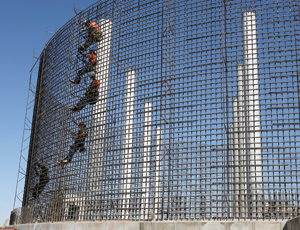The economy’s dizzying downward spiral has left few unaffected, and contractors that work in the environmental sector are no exception. But firms report the lukewarm environmental market may be starting to heat up, due in part to an infusion of federal funds from the American Recovery and Reinvestment Act (ARRA) and expected increases in federal funding for water, wastewater and Superfund cleanup projects.

“I think overall we’ve seen the business flat but starting to pick back up in the tail end of the second quarter,” says Alan Krause, president and chief operating officer of Broomfield, Colo.-based MWH. Krause says MWH had a “healthy” backlog through the end of last year’s third quarter, but then started to run into project delays. “The work we had, much of it continued, but at a slower pace and now it’s starting to come back.”
Harvey Coppage, director of environmental services for the federal division for Overland Park, Kan.-based Black & Veatch, attributes at least some of the uptick to anticipation of more ARRA funding. “In the last six months, on the strength of the promise of the stimulus funding, there’s been a little bit more activity,” he says. However, many of the funds that have been allocated are going to work that was already in the pipeline.
For example, stimulus funds will be applied to a contract awarded to Black & Veatch in August from the U.S. Environmental Protection Agency, Coppage says. The award, a renewal of a previous 10-year contract, covers cleanup work in eight southern states for up to 10 years and $150 million.
Stimulus money also has been directed to a $379.5-million contract awarded to The Shaw Group, Baton Rouge, for the U.S. Army Corps of Engineers’ Maywood, N.J., Superfund site, says George Bevan, president of Shaw’s environmental and infrastructure group. The stimulus funds have enabled Shaw, which has been working at the site since 1999, to hire more workers on continuing remediation as part of the Corps’ Formerly Utilized Sites Remedial Action program.
Luis Ventoza, regional vice president of Edmonton-based PCL Constructors says his firm has received stimulus funds on two water-related projects. “Had [the projects] not received the money, they would have been shelved,” he says.
While firms report a modest infusion of funds through ARRA, they expect to see more of an impact later in 2010 and into 2011. “What we are hearing is that the money is slow coming in, and we may see more projects with stimulus money [in] 2010,” Ventoza says.
For some firms, the eagerly anticipated stimulus windfall has yet to materialize. “For the work that we are doing on the environmental side, the stimulus has not had an impact,” says Steve Robinson, a senior vice president at Tempe, Ariz.-based Sundt Construction. Robinson says Arizona, where the firm does a significant amount of its work, received a relatively small portion of the total ARRA funds allocated. “We have been disappointed that the stimulus money has not surfaced for us yet,” MWH’s Krause adds. “We think it will come, but we haven’t seen it yet.”
Alternative Delivery
Some firms say the design-build approach has helped them to weather the difficult economic times. “It’s a lot more resilient to recession,” says Paul Shea, president of CDM Constructors, Inc., the Denver-based construction arm of Cambridge, Mass.-based CDM.
A study released this spring by the Water Design-Build Council found use of design-build on water and wastewater projects in the U.S. has increased significantly. The report, a four-year analysis of the Water Design-Build Council’s member firms, shows the sales value for design-build projects grew nearly 80% in 2008, to $2.2 billion, representing 89 new projects. “Increasingly municipalities are working with design-build firms to address the need to repair, improve and expand their water and wastewater treatment facilities,” says Peter Tunnicliffe, president of the Water Design-Build Council and a senior vice president with CDM.
PCL is the design-builder on an $81.4-million project for the San Francisco Utilities Commission. The project will provide a new 315-million-gallon-per-day drinking water plant that uses ultraviolet disinfection and new chemical storage facilities to help SFUC to comply with more stringent federal surface-water-quality regulations that are to take effect in April 2012. The plant will replace the existing facility in San Joaquin County, where water from the Hetch Hetchy Reservoir transitions from the San Joaquin pipelines to the Coast Range tunnel.
CDM designed and is building a $50-million wastewater treatment and reclamation plant in Okaloosa County, Fla. The 10-mgd plant will provide tertiary treatment to remove biological nutrients and use ultraviolet disinfection to treat effluent for groundwater recharge. CDM says the design-build approach allowed final project design to be completed in five and a half months.
Firms also report municipal clients increasingly are concerned about their carbon footprint and finding ways to reduce energy costs. Dan McCarthy, president and CEO of Black & Veatch’s global water business, says utilities are looking at the “nexus” between energy and water with an eye toward reducing costs. “There’s a lot of opportunity to capture energy for systems that [previously] have not been as efficient as they could have been,” he says.
In August, Black & Veatch was awarded a contract to design and oversee construction of an energy-recovery project that will burn biosolids to produce power for Hartford, Conn.’s Metropolitan District Commission. Black & Veatch will upgrade incinerators that burn biosolids at an 80-mgd wastewater treatment plant to generate steam, which will power a turbine that produces an estimated 1.5 MW of electricity per hour, approximately 40% of the facility’s annual electricity consumption.
“By harnessing energy produced on-site and utilizing it as a renewable energy source, the facility will remain an environmentally sound and socially responsible one with more flexibility and efficiency,” McCarthy says.
| Rank* | Firm |
|---|---|
| 1 | Layne Christensen Co. |
| 2 | Kiewit Corp. |
| 3 | Garney Holding Co. |
| 4 | Skanska USA Inc. |
| 5 | The Walsh Group Ltd. |
| 6 | Barnard Construction Co. Inc. |
| 7 | Black & Veatch |
| 8 | PCL Construction Enterprises Inc. |
| 9 | Shimmick Construction Co. Inc. |
| 10 | MWH Global |
| 11 | URS Corp. |
| 12 | CB&I |
| 13 | Cajun Industries LLC |
| 14 | Alberici Corp. |
| 15 | Teichert Construction |
| 16 | Sundt Construction Inc. |
| 17 | Fred Weber Inc. |
| 18 | John P. Picone Inc. |
| 19 | CDM |
| 20 | Wharton-Smith Inc. |
| *BASED ON 2008 CONTRACTING REVENUE FROM WATER SUPPLY AS REPORTED IN ENR’S SURVEY OF LEADING CONTRACTORS AND DESIGN FIRMS. | |



Post a comment to this article
Report Abusive Comment